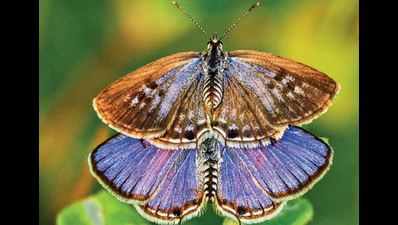- News
- City News
- delhi News
- Wings of change: Delhi keeps a count
Trending
This story is from September 24, 2018
Wings of change: Delhi keeps a count

NEW DELHI: The second edition of Delhi’s ‘Big Butterfly Count’ kicked off on Sunday with over 50 locations covered across NCR — a significant rise from the 17 locations covered last year. Hundreds of butterfly lovers and lepidopterists set out with a checklist and a camera to record the different butterfly species, the results of which will be declared next week.Last year’s census recorded 69 species.
The butterfly count was organised by the Bombay Natural History Society (BNHS) at Asola, in association with the Delhi forest and wildlife department and is part of Delhi’s ‘big butterfly month’. Officials said the increase in location count has been due to plans of developing a contiguous butterfly corridor between Asola Bhatti and Yamuna Biodiversity Park.

Some of the locations covered on Sunday included Asola Bhatti Wildlife Sanctuary, Yamuna Biodiversity Park, Okhla Bird Sanctuary, Aravalli Biodiversity Park, Neela Hauz, Tughlakabad, Sanjay Van, Mangar Bani, Surajpur wetlands, Dhanauri, Buddha Jayanti Park, Yamuna floodplains, Lodhi Garden, among others.
According to experts, a number of locations have recorded a spike in the number of species as compared to last year. At Yamuna Biodiversity Park (YBP), 46 species were recorded as compared to 42 last year. Neela Hauz, Northern Ridge, Tilpath Valley and Tughlakabad Biodiversity Park have also registered an increase in species.
“Host plant quality is a significant factor for reproductive output in insects, including butterflies. Individuals feeding on poor quality plants grow smaller with lower reproductive potential,” said Faiyaz Khudsar, scientist in-charge at YBP.
The butterfly count was organised by the Bombay Natural History Society (BNHS) at Asola, in association with the Delhi forest and wildlife department and is part of Delhi’s ‘big butterfly month’. Officials said the increase in location count has been due to plans of developing a contiguous butterfly corridor between Asola Bhatti and Yamuna Biodiversity Park.

Some of the locations covered on Sunday included Asola Bhatti Wildlife Sanctuary, Yamuna Biodiversity Park, Okhla Bird Sanctuary, Aravalli Biodiversity Park, Neela Hauz, Tughlakabad, Sanjay Van, Mangar Bani, Surajpur wetlands, Dhanauri, Buddha Jayanti Park, Yamuna floodplains, Lodhi Garden, among others.
“An attempt has been made to move on from only conducting counts in forest areas to covering urban clusters and green corridors, which have been identified over the last year. This year’s count will be truly urban and a better reflection of butterfly population in Delhi,” said Sohail Madan, centre manager at BNHS and one of the team leaders for the census.
According to experts, a number of locations have recorded a spike in the number of species as compared to last year. At Yamuna Biodiversity Park (YBP), 46 species were recorded as compared to 42 last year. Neela Hauz, Northern Ridge, Tilpath Valley and Tughlakabad Biodiversity Park have also registered an increase in species.
“Host plant quality is a significant factor for reproductive output in insects, including butterflies. Individuals feeding on poor quality plants grow smaller with lower reproductive potential,” said Faiyaz Khudsar, scientist in-charge at YBP.
End of Article
FOLLOW US ON SOCIAL MEDIA










